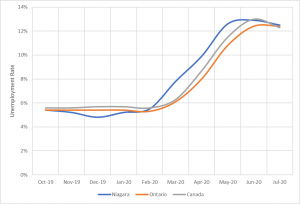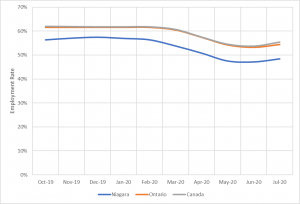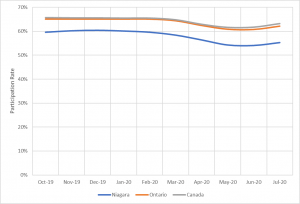Vital updates:
- President Trump has announced the restoration of a 10% tariff on Canadian aluminum beginning on August 16th. The announcement was made in Ohio, a battleground state in which Democratic candidate Joe Biden is making significant gains. Ottawa has promised to enact $3.6 billion in retaliatory tariffs from a list drawn up in consultations made over the last 30 days, anticipating this contingency. In 2018, the Government of Canada retaliated against U.S. steel and aluminum tariffs by targeting the economies of Republican-held states. The governments of Ontario and Canada and the U.S. and Canadian Chambers of Commerce have already expressed their opposition to this move. The GNCC has condemned the tariffs, which will cause economic problems on both sides of the border and higher prices for consumers at a time when no government can afford either. U.S. aluminum supplies are insufficient to meet domestic demand, so rather than supporting domestic production of aluminum, the tariffs will simply mean higher costs for U.S. manufacturers, which will be passed on to customers.
- Statistics Canada has released the July data from its monthly Labour Force Survey. The unemployment rate was 10.9% in July, falling 1.4 percentage points for the second consecutive month and down from a record high of 13.7% in May. The unemployment rate was 5.6% in February. Employment rose by 419,000 (+2.4%) in July, compared with 953,000 (+5.8%) in June. Combined with gains of 290,000 in May, this brought employment to within 1.3 million (-7.0%) of its pre-COVID February level. The number of Canadians who were employed but worked less than half their usual hours for reasons likely related to COVID-19 dropped by 412,000 (-18.8%) in July. Combined with declines recorded in May and June, this left COVID-related absences from work at just under 1 million (+972,000; +120.3%) above February levels.
- Most of the employment gains in July were in part-time work, which increased by 345,000 (+11.3%), compared with a much smaller increase of 73,000 (+0.5%) in full-time work. Growth in part-time employment has outpaced full-time growth in each of the past three months.
- In July, employment rose faster among women (+3.4% or +275,000) than men (+1.5% or +144,000). Due to heavier employment losses among women in March, however, employment in July was closer to its pre-shutdown level for men than for women. As of July, men in the core-age group of 25 to 54, who were least affected by the shutdown, had recovered to within 4.4% of their February employment level. Employment for women in this age group was within 5.7% of pre-COVID levels. Female youth (aged 15 to 24) were the furthest from their February employment level (-17.9%), followed by young men (-16.9%) in the same age group.
 Among those who were employed and not absent from work, the number working from home dropped by 400,000, compared with an increase of 300,000 in the number working at locations other than home. Despite this decline, the number of Canadians who worked from home in July (4.6 million) remained significantly higher than the number who usually do so (1.6 million).
Among those who were employed and not absent from work, the number working from home dropped by 400,000, compared with an increase of 300,000 in the number working at locations other than home. Despite this decline, the number of Canadians who worked from home in July (4.6 million) remained significantly higher than the number who usually do so (1.6 million).- While the unemployment rate fell among all major age-sex groups in July, it was higher for men (11.3%) than for women (10.4%). The unemployment rate for male youth aged 15 to 24 (26.7%) continued to be higher than that of all other groups, including female youth (21.3%). Among those in the core working age of 25 to 54, the unemployment rate was virtually the same for men (8.8%) and women (8.7%). In July, temporary layoffs declined strongly for a second consecutive month, down 384,000 (-45.5%).
 In July, under one-quarter (22.4%) of the potential labour force was fully or partially underutilized. This was down notably from more than one-third in April (36.1%), but substantially higher than pre-pandemic levels (11.2% in February). Labour underutilization occurs when people who could potentially work are not working or when people could work more hours than they are currently.
In July, under one-quarter (22.4%) of the potential labour force was fully or partially underutilized. This was down notably from more than one-third in April (36.1%), but substantially higher than pre-pandemic levels (11.2% in February). Labour underutilization occurs when people who could potentially work are not working or when people could work more hours than they are currently.- The national unemployment rate disguises significant variation across population groups. When unadjusted for seasonality, the national unemployment rate for those aged 15 to 69 was 11.3% in July. Several groups had rates of joblessness significantly above this average, including South Asian (17.8%), Arab (17.3%), and Black (16.8%) Canadians. Among South Asian Canadians, women (20.4%) had a significantly higher unemployment rate than men (15.4%). Black women also had a higher unemployment rate than Black men (18.6% vs 15.1%).
 In July, as the continued easing of COVID-19 restrictions allowed Canadians to return to restaurants and outdoor patios, employment rose by 101,000 (+12.3%) in accommodation and food services, the third consecutive monthly increase. Despite these gains, employment in the industry was only 74.9% of its February level. The number of people employed in retail trade grew by 91,000 (+4.6%) in July, bringing employment to 92.7% of its February level.
In July, as the continued easing of COVID-19 restrictions allowed Canadians to return to restaurants and outdoor patios, employment rose by 101,000 (+12.3%) in accommodation and food services, the third consecutive monthly increase. Despite these gains, employment in the industry was only 74.9% of its February level. The number of people employed in retail trade grew by 91,000 (+4.6%) in July, bringing employment to 92.7% of its February level.- In Ontario, employment rose by 151,000 (+2.2%) in July, building on an increase of 378,000 in June and bringing employment to 91.7% of its pre-pandemic February level.
- In the St. Catharines-Niagara CMA (which does not include Grimsby or West Lincoln), the unemployment rate eased from 12.9% in June to 12.4% in July. The local unemployment rate in July 2019 was 5.6%. Labour force participation increased from 54.1% to 55.3%, still below the 2019 level of 58.2%. The employment rate increased from 47.1% in June to 48.4%, against a July 2019 figure of 54.9%. The local youth unemployment rate is 31.3%, and of those re-entering the local labour force, 4,000 were men, and 1,700 were women. Out of 6,900 new or restored jobs in Niagara since June, 6,200 were full-time. Local data, unlike national and provincial data, is based on a 3-month moving average, and is seasonally adjusted. This tends to smooth out seasonal swings and to “pull” the latest data closer to figures seen in the preceding two months.
Reading recommendations:
- A second COVID-19 wave? Here are 6 lessons from the first, Loren Falkenberg & Jillian Walsh, The Conversation
- What Lockdown 2.0 Looks Like: Harsher Rules, Deeper Confusion, Damien Cave, The New York Times
- Reward Your Employees — Without Breaking the Bank, Sanjiv Das, Harvard Business Review
- Covid-19 lockdown will have ‘negligible’ impact on climate crisis – study, Damian Carrington, The Guardian
If you are showing symptoms, contact your health care provider, call the Public Health Info-Line at 905-688-8248, or chat to Public Health online. For testing, call 905-378-4647 ext. 42819 (4-CV19) for information on test centres in Niagara and to book an appointment.
Remember that a COVID-19 test is only a snapshot of your health on the specific date and time the swab was taken. No testing is perfect and a negative result doesn’t mean you haven’t been exposed to COVID-19. You can still develop symptoms days after your test was taken.
It is important that everyone practice physical distancing to prevent the spread of COVID-19. Maintain a 2-metre distance from other people. When maintaining distance is impossible, wear a mask or face covering. Wash hands frequently and thoroughly. Avoid touching the face. If you have recently traveled outside the country, you are legally required to self-isolate for 14 days.
Previous updates can be accessed here.
Stay safe and be vigilant. The GNCC is here to support you. Contact us with any questions you have.



